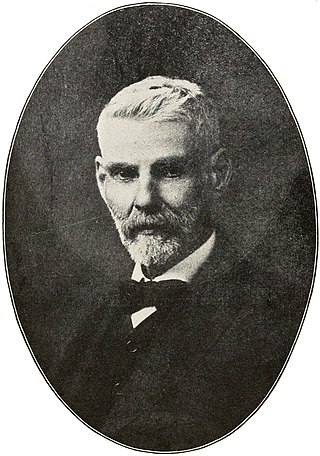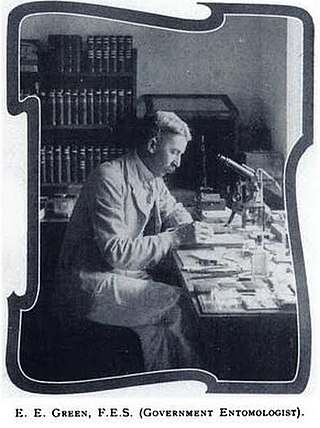Related Research Articles

The Ichneumonidae, also known as ichneumon wasps, ichneumonid wasps, ichneumonids, or Darwin wasps, are a family of parasitoid wasps of the insect order Hymenoptera. They are one of the most diverse groups within the Hymenoptera with roughly 25,000 species described as of 2016. However, this likely represents less than a quarter of their true richness as reliable estimates are lacking, along with much of the most basic knowledge about their ecology, distribution, and evolution. It is estimated that there are more species in this family than there are species of birds and mammals combined. Ichneumonid wasps, with very few exceptions, attack the immature stages of holometabolous insects and spiders, eventually killing their hosts. They thus fulfill an important role as regulators of insect populations, both in natural and semi-natural systems, making them promising agents for biological control.

Alexander Henry Haliday was an Irish entomologist. He is primarily known for his work on Hymenoptera, Diptera, and Thysanoptera, but worked on all insect orders and on many aspects of entomology.

Augustus Radcliffe Grote was a British entomologist who described over 1,000 species of butterflies and moths. He is best known for his work on North American Noctuidae. A number of species were named after him, including the moth Horama grotei.

Walther Hermann Richard Horn was a German physician and entomologist who specialised in beetles (Coleoptera), particularly the tiger beetles. He became the founding director of the German entomological institute where he collaborated with entomologists around the world. He is not to be confused with the American entomologist George Henry Horn who also studied Coleoptera.
Ezra Townsend Cresson was an American entomologist who specialized in the Hymenoptera order of insects. He wrote Synopsis of the families and genera of the Hymenoptera of America, north of Mexico Philadelphia: Paul C. Stockhausen, Entomological printer (1887) and many other works. Cresson also documented many new species including Nomada texana.

Herbert Huntingdon Smith or Herbert Huntington Smith was an American naturalist and amateur conchologist who worked on the flora and fauna of Brazil. He wrote Brazil, the Amazons and the coast and Do Rio de Janeiro á Cuyabá: Notas de um naturalista (1922).

Edward Ernest Green was a Ceylon-born English mycologist and entomologist who specialised in the scale-insects, Coccidae. An accomplished artist, and lithographer, he illustrated the five volume Coccidae of Ceylon.
Clell Lee Metcalf was an American entomologist who specialised in Diptera. He worked on treatises on the Syrphidae of Maine and, along with Wesley Pillsbury Flint (1883–1943), wrote Destructive and useful insects; their habits and control, a major work on insect pests, while he taught at the University of Illinois.

František Antonín Nickerl was a Czech entomologist who specialised in Lepidoptera, especially those of the Riesengebirges.

Joseph Albert Lintner was an American entomologist who held the position of state entomologist from 1881, following the creation of this post by the federal government, until 1898. Lintner wrote 900 scientific papers and 13 entries of the Report on the injurious and other insects of the State of New York on crop pests and injurious insects associated with agriculture. Lintner's collection is in the New York State Museum.

Ernst Otto Wilhelm Taschenberg was a German entomologist who specialised in Hymenoptera.

Alexander Mocsary, sometimes Hungarian: Mocsáry Sándor was a Hungarian entomologist who specialised in Hymenoptera.
Harry Frederick Dietz was an American economic entomologist.
Augustus Busck was a Danish-American entomologist with the United States Department of Agriculture's Bureau of Entomology. He is best known for his work with microlepidoptera, of which he described over 600 species. His collections of Lepidoptera from North America and the Panama Canal Zone are held by the National Museum of Natural History in Washington, D.C.

James Chester Bradley was an American entomologist who specialised in Hymenoptera.
Diadegma chrysostictos is a wasp first described by J.F. Gmelin in 1790. No subspecies are listed.
Diadegma compressum is a wasp first described by Cresson in 1864. No subspecies are listed.
Herbert Osborn was an American entomologist.

Homer Franklin Bassett was an American hymenopterist specializing in gall wasps. In addition, he was the librarian of Silas Bronson Library in Waterbury, Connecticut.

Trogus is a genus of parasitoid wasp found in the Holarctic and Neotropic regions. It is placed in the subfamily Ichneumoninae and the tribe Ichneumonini. Trogus species are parasites of larvae and pupae of the swallowtail butterfly family, Papilionidae. The genus consists of twelve extant and one extinct species.
References
- Mallis, A. 1971 American Entomologists. Rutgers Univ. Press New Brunswick.
- Osborn, H. 1937 Fragments of Entomological History Including Some Personal Recollections of Men and Events. Columbus, Ohio, Published by the Author.
- Osborn, H. 1952 A Brief History of Entomology Including Time of Demosthenes and Aristotle to Modern Times with over Five Hundred Portraits. Columbus, Ohio, The Spahr & Glenn Company.